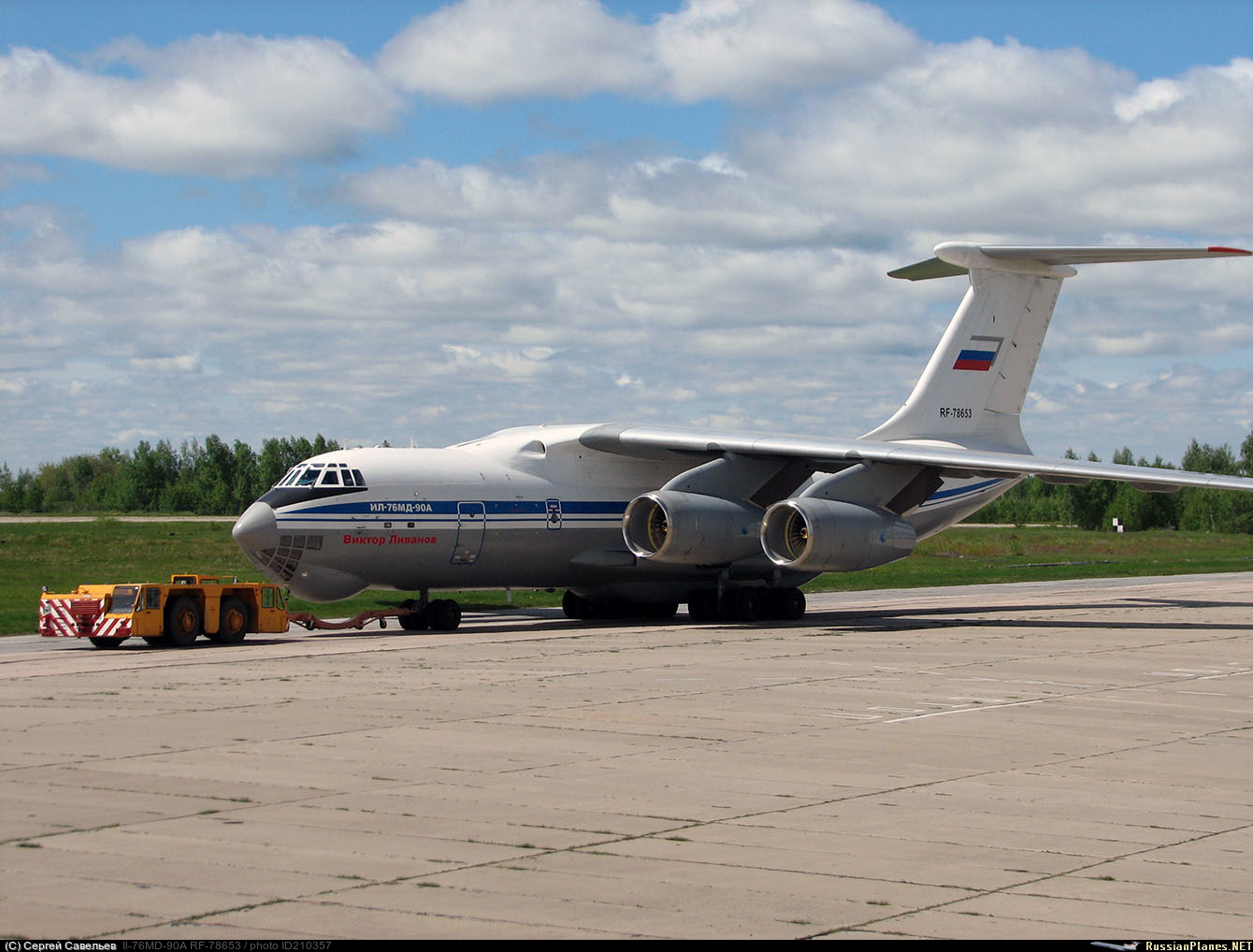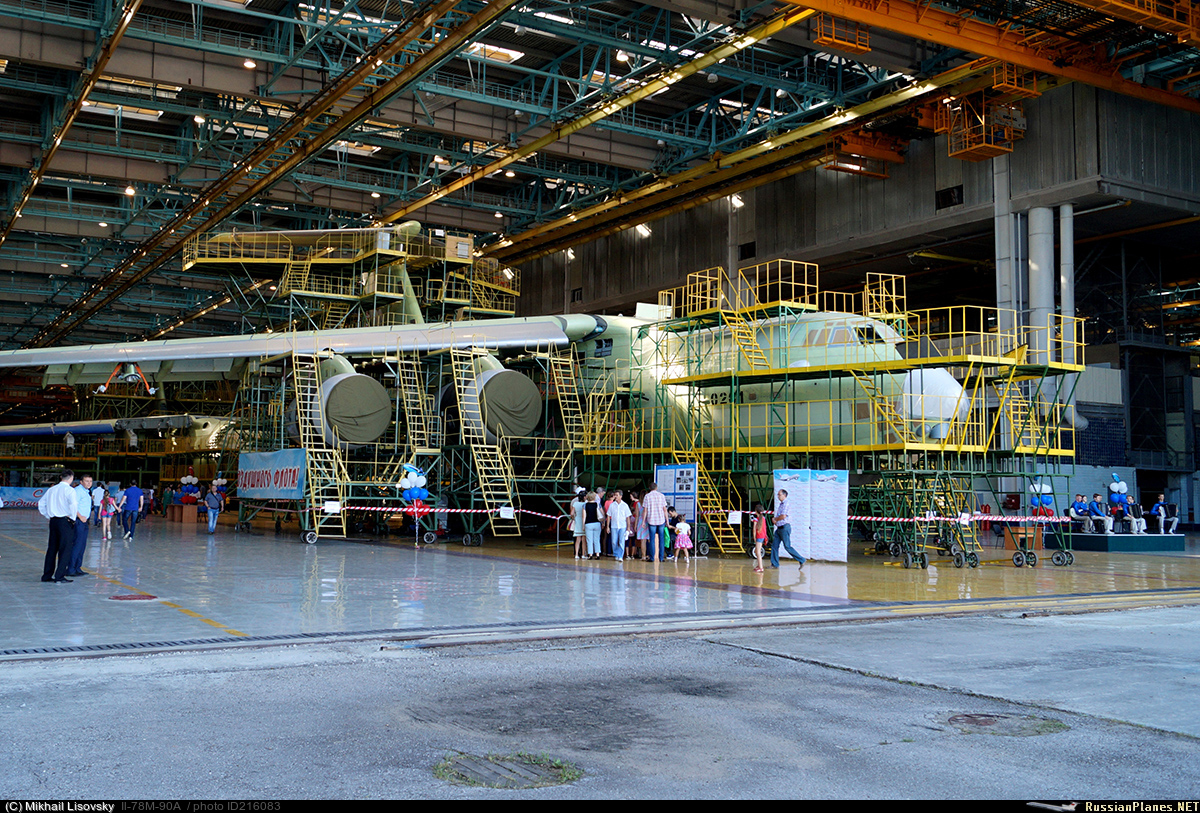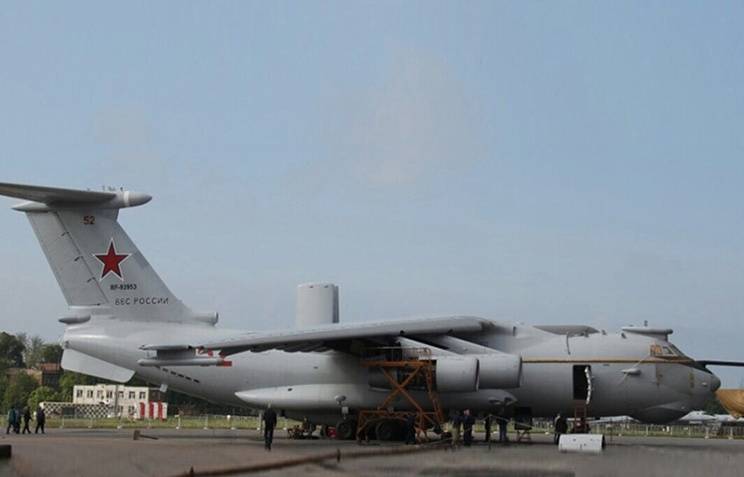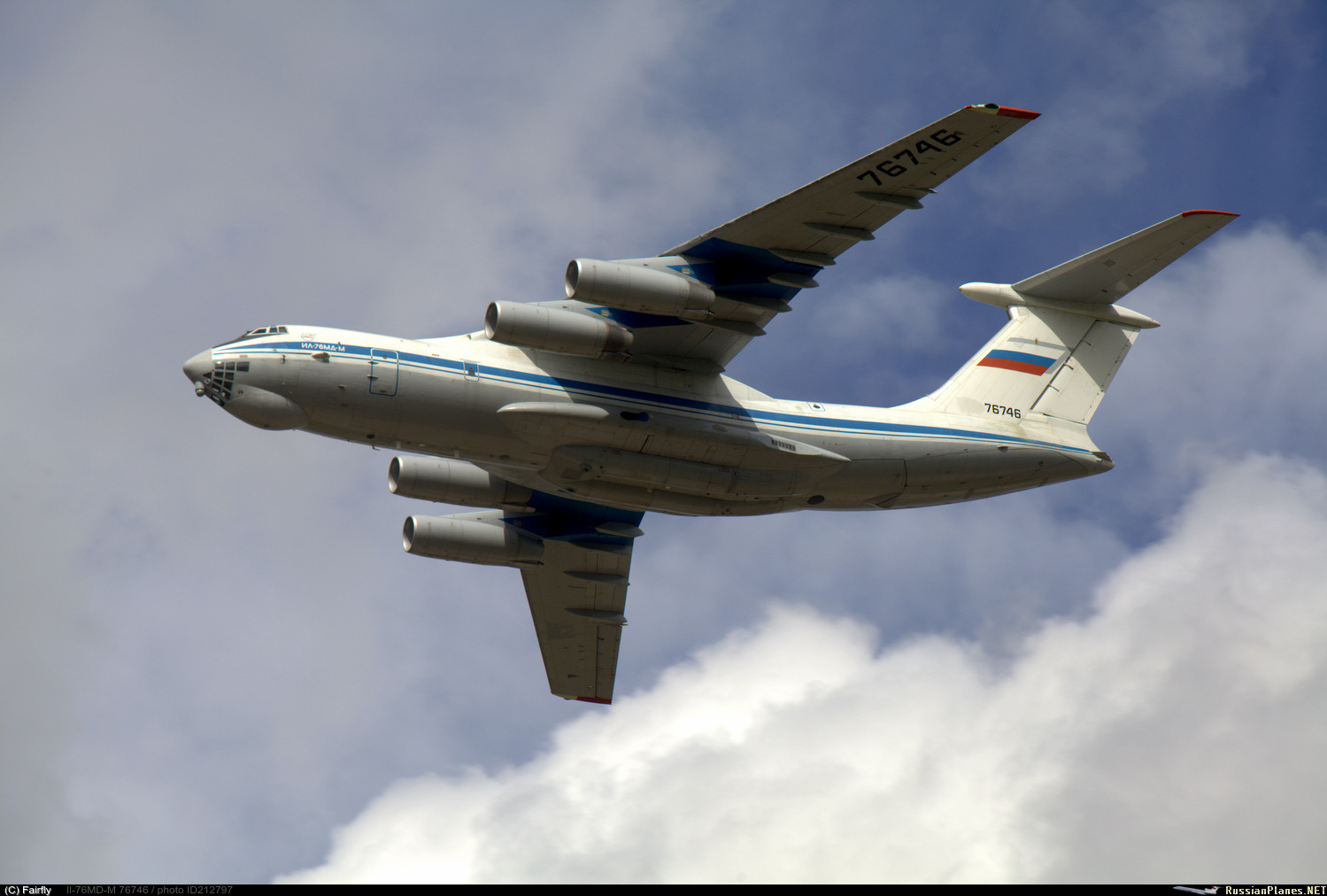T-47 wrote:Tsavo Lion wrote:IL-96TZ (tanker) project was cancelled.
Seriously? From which source?
Interview of Yuri Slyusar which confirms that the IL-96-400TZ is still alive and kicking.
https://www.kommersant.ru/doc/3360057
 Re: Russian Transport Aircraft fleet (VTA)
Re: Russian Transport Aircraft fleet (VTA)T-47 wrote:Tsavo Lion wrote:IL-96TZ (tanker) project was cancelled.
Seriously? From which source?
 Re: Russian Transport Aircraft fleet (VTA)
Re: Russian Transport Aircraft fleet (VTA)I always wondered, why the AN-124 has conventional, not T tail like on the IL-76, C-141/17/5? Isn't the air turbulence affecting horizontal stabilizers directly behind the wings?
 Re: Russian Transport Aircraft fleet (VTA)
Re: Russian Transport Aircraft fleet (VTA)As far as military transports are concerned, he talks about new IL-76/78s (using his production #s, it = 40 IL-78s will be ready in ~ 5 years), w/o any mention of IL-96-400TZ in the discussion on the civilian IL-96-400, which btw, needs gov. help as it's not economically feasible in its present 4 engine form. Should oil prices go up, it'll be even less so. https://www.ruaviation.com/docs/5/2016/4/13/104/Interview of Yuri Slyusar which confirms that the IL-96-400TZ is still alive and kicking. https://www.kommersant.ru/doc/3360057
In the only 1 crash of AN-124, its tail design didn't cause it: https://en.wikipedia.org/wiki/1997_Irkutsk_Antonov_An-124_crashThe conventional tail design is the most common form. It has one vertical stabilizer placed at the tapered tail section of the fuselage and one horizontal stabilizer divided into two parts, one on each side of the vertical stabilizer. For many airplanes, the conventional arrangement provides adequate stability and control with the lowest structural weight. About three-quarters of the airplanes in operation today, including the Airbus A300, the Boeing 777 and 747, and the Beech Bonanza A-36, use this arrangement.
..the horizontal stabilizer in the T-tail layout imposes a bending and twisting load on the vertical stabilizer, requiring a stronger, and therefore, a heavier, structure. These loads are avoided in the conventional design. There is also the possibility that at the high pitch angle usually associated with landing the airplane, the horizontal stabilizer of the T tail will be immersed in the slower and more turbulent flow of the wing wake. In some cases, it is possible to compromise severely the control function of the horizontal tail. Nevertheless, the T tail is the second-most common tail design after the conventional. Both major American transport plane builders, Boeing and McDonnell-Douglas, use the T-tail design. The Boeing 727, with its three fuselage-mounted engines, has a T-tail design, as do the variants of the McDonnell Douglas MD-90, formerly the Douglas DC-9. Other aircraft that employ the T-tail design are the Lockheed C-5A, the Gates Lear-jets 23 and 35A, the Cessna Citation CJ1, the Piper Lance II, and the Beech Skipper 77. http://what-when-how.com/flight/tail-designs/
The T-tail sticks the elevators out of the disturbed air of the wings, prop, and (usually most of) the fuselage which gives you better elevator authority, and makes a tail stall less likely. .. using conventional tail leads to the fact that the airflow over the tail might be disturbed by the main wing and/or the engines and/or the fuselage. However, the downwash induced by the main wing on the flow is taken into account (for the cruise conditions) in the design of the tail in order to reduce some negative aspects of the interaction between the main wing and the tail. ..From a structural point of view, when flying transonic (or even supersonic) it is not good to have a T-tail configuration because it usually induces flutter on the tail.
Finally, at a lower level but still a difference, using a T-tail increases the wake (compared to a conventional configuration, where the tail is almost in the wake of the main wings and the fuselage) behind your aircraft and thus the drag you need to overcome is larger. https://aviation.stackexchange.com/questions/1400/how-do-conventional-and-t-tails-differ
Conventional tails have the advantage in terms of SYSTEM REDUNDANCY. Conventional tails can more easily equipped with hydraulic, wire, or mechanical systems that have no single point of failure. ..The conventional (lower) location for the horizontal stabilizer puts less stress on the vertical stabilizer. Therefore the vertical stabilizer can be lighter. ..Additional considerations are that the lower stabilizer location results in easier access for inspections and maintenance. https://answers.yahoo.com/question/index?qid=20080307040012AAP6aKl

 Re: Russian Transport Aircraft fleet (VTA)
Re: Russian Transport Aircraft fleet (VTA)Tsavo Lion wrote:As far as military transports are concerned, he talks about new IL-76/78s (using his production #s, it = 40 IL-78s will be ready in ~ 5 years), w/o any mention of IL-96-400TZ in the discussion on the civilian IL-96-400Interview of Yuri Slyusar which confirms that the IL-96-400TZ is still alive and kicking. https://www.kommersant.ru/doc/3360057
 Re: Russian Transport Aircraft fleet (VTA)
Re: Russian Transport Aircraft fleet (VTA) Re: Russian Transport Aircraft fleet (VTA)
Re: Russian Transport Aircraft fleet (VTA)I was expecting this. W/o the AN-70, some of them'll need to take their roles as well: https://theaviationist.com/2017/10/03/russian-il-76-candid-modified-to-support-special-operations-conducts-flight-test-over-the-black-sea/Lieutenant General Vladimir Benediktov, head of Russia’s military transport aviation command (Voyenno-Transportnoy Aviatsii, VTA), announced at the beginning of October that the Russian Air Force would require 150-200 new Il-76MD-90A transports by the end of the 2020s. ..The VTA currently has 144 Il-76 transports in service, the oldest of which was delivered to the Soviet Air Force around 1981. Up to 14 of them have been upgraded to the MD-90 standard with new PS-90A-76 engines in the last 10 years. Despite this, it is estimated that more than 50% of the current Il-76 fleet is grounded in a non-airworthy condition. This is putting an ever increasing strain on the ones that are airworthy.
It is believed that five MD-90A variants have been completed, the first four as test aircraft and the fifth delivered to the VTA's 610th Centre for Combat Employment and Personnel Retraining at Ivanovo Air Force Base. http://www.janes.com/article/74711/russia-orders-vta-il-76md-90a-transports
 Re: Russian Transport Aircraft fleet (VTA)
Re: Russian Transport Aircraft fleet (VTA) Re: Russian Transport Aircraft fleet (VTA)
Re: Russian Transport Aircraft fleet (VTA) Re: Russian Transport Aircraft fleet (VTA)
Re: Russian Transport Aircraft fleet (VTA) Re: Russian Transport Aircraft fleet (VTA)
Re: Russian Transport Aircraft fleet (VTA) Re: Russian Transport Aircraft fleet (VTA)
Re: Russian Transport Aircraft fleet (VTA)Unless Ukraine is swallowed by Russia & revives it. But even if not, I'm not putting a cross over it yet. If they could/are soon to start producing AN-124s/their follow-ons & move production of IL-76s from Uzbekistan, I don't see why the same can't be done with AN-70 &/ its proposed variants. IL-76 (old & new) is an overkill (in all aspects) as a substitute, & IL-112/114 are jokes compared with it.GarryB wrote:It is basically a Ukrainian plane that Russia put money into... there will be no Russian An-70.
 Re: Russian Transport Aircraft fleet (VTA)
Re: Russian Transport Aircraft fleet (VTA)They could also build stretched IL-76MFD-90A to get more bang for the buck-
The AN-70 saga may continue to RF favour once the Kiev regime is gone.
Unless Ukraine is swallowed by Russia & revives it.
IL-76 (old & new) is an overkill (in all aspects) as a substitute, & IL-112/114 are jokes compared with it.
 Re: Russian Transport Aircraft fleet (VTA)
Re: Russian Transport Aircraft fleet (VTA)For comparison, the latter costs $58M, ~3 times less. http://www.deagel.com/Support-Aircraft/Il-476_a000368004.aspxComparable strategic airlifters include the propfan-powered Airbus Defence & Space (DS) A400M and Antonov (under UkroBoronProm) An-70. Russia’s VTA IL-76MD-90A is a jet-powered alternative. The Airbus DS A400M has a payload of 30 tons, with which it can fly a range of 4,500 km (and 6,400 km with a 20-ton payload). With a 35-ton payload, the An-70 can fly 5,100 km, but the platform is not in production. UkroBoronProm is hoping to revive the An-70 with U.S. industry support under the Antonov An-77 program. The IL-76MD-90A can reach 5,000 km with a 52-ton payload.
The An-70 exceeds.. the A400M (the purchase and operation costs of the An-70 are twice lower). The max.weight capacity of the An-70 is 47 tonnes.
http://open4business.com.ua/ukrainian-military-transport-aircraft-an-70-passes-direct-test-in-africa/
 Re: Russian Transport Aircraft fleet (VTA)
Re: Russian Transport Aircraft fleet (VTA)eehnie wrote:Data by weight class, updated in 2017 from Russianplanes.net and other complementary sources:
-
Active 010 Reserve 016 Production 1984-Today An-124
Active 005 Reserve 000 Production 1979-Today Il-86/80/96
Active 006 Reserve 003 Production 1966-1975 An-22
Active 146 Reserve 071 Production 1973-Today Il-76/78/A-50
Active 007 Reserve 002 Production 1966-Today Il-62
Active 004 Reserve 000 Production 1990-Today Tu-204/214
Active 018 Reserve 003 Production 1969-Today Tu-154
Active 000 Reserve 000 Production 2010-Today Su-Superjet100
Active 031 Reserve 054 Production 1980-Today Mi-26/27
Active 000 Reserve 000 Production 1976-2003 Yak-42/142: http://russianplanes.net/planelist/Yakovlev/Yak-42
Active 064 Reserve 102 Production 1964-1989 Tu-134
Active 048 Reserve 007 Production 1959-1985 Il-18/20/22/24
Active 060 Reserve 059 Production 1957-1972 An-10/12
Active 028 Reserve 019 Production 1985-Today An-72/71/74
Active 000 Reserve 019 Production 1960-1980 Mi-6/10
Active 159 Reserve 145 Production 1962-Today An-24/26/30/32
Active 000 Reserve 000 Production 2017-Today Mi-38
Active 089 Reserve 000 Production 2009-Today Yak-130
Active 130 Reserve 074 Production 1980-Today Ka-27/28/29/31/32
Active 000 Reserve 000 Production 2017-Today Ka-60/62
Active 036 Reserve 000 Production 2013-Today Mi-Ansat
Active 041 Reserve 000 Production 2004-Today Ka-226
Active 000 Reserve 000 Production 1995-Today Il-103: https://en.wikipedia.org/wiki/Ilyushin_Il-103
Active 000 Reserve 000 Production 1985-Today Yak-55/54/56: https://www.aviaport.ru/directory/aviation/jak54/
Active 000 Reserve 000 Production 1984-Today Su-26/29/31: https://en.wikipedia.org/wiki/Sukhoi_Su-29
Active 099 Reserve 240 Production 1977-1998 Yak-52
Active 015 Reserve 005 Production 1966-1993 Mi-2
Active 036 Reserve 038 Production 1950-1991 An-2
Including all the most modern Russian and Sovietic successful aircrafts and helicopters with production over 50 units, plus the Mi-38 and the Ka-60/62 which mass production begins now, are expected to be a success, and have been ordered by the Russian Armed Forces. Not included foreign aircrafts that are likely to disappear soon from the Russian Armed forces (by sale, transfer to other governmental ministries or other way):
Active 010 Reserve 000 Production 2009-Today An-148/158/178 in the weignt clas of the An-72/74
Active 009 Reserve 000 Production 1997-Today An-140 in the weight class of the An-24/26/30/32
Active 029 Reserve 070 Production 1970-2015 L-410 in the weight class of the Ka-60/62
Active 200 Reserve 000 Production 1977-1998 L-39 in the weight class of the Mi-Ansat
Green means production available for Russia. Blue means unlikely to reach the Russian Armed Forces. Purple is related with foreign aircrafts likely to disappear soon, and red is related with the proportion of units in active service or reserve produced in 1975 or before. Totally red means all the units in the Russian Armed Forces produced in 1975 or before. In the case of the An-2 only 2 units have been produced after 1975. In the case of the Mi-2 the number of units produced after 1975 is exactly the number of units in active service.
Between the 6 biggest cathegories aircrafts are dominant. Between the 5 smaller cathegories the helicopters would be dominant despite to be not present in all the cathegories, taking into account the success of the Mi-26/27 (bigger than the success of the An-72/71/74, with higher number of units produced). In the future I would expect:
- Transport aircrafts to be successful in the 2nd to 6th cathegories (since 20 tons payload).
- Airliner aircrafts to be successful in the 3rd to 6th cathegories (since 95-100 passengers + mid range >5000Km).
- Helicopters to be successful in the 6th to 11th cathegories (until 20 tons payload).
- Trainer aircrafts to be successful in the 9th and 11th cathegories.
- Trainer helicopters to be successful in the 11th cathegory.
The success is uncertain for the rest of the options. As overall rule, I would avoid to invest on them.
According to this and recovering the results about priorities of my previous comment, that come from here, this would be the order of priority for non-combat aircrafts and helicopters:
0.- Su-SJ100 (I expect some order from the Russian Armed Forces in the short term).
1.- Mi-46 (in the An-24/26/30/32 size class with around 10 tons payload).
2.- Il-214 40 or Tu-330 or Be A-40/42 (in the Tu-204/214 size class with around 40 tons payload).
3.- Ka-102 (in the An-72/74 size class with around 15 tons payload).
4.- PTS 80 or Il-106 (in the An-22 size class with around 80 tons payload).
5.- Il-214 or Tu-230 (in the An-10/12 size class with around 20 tons payload).
6.- PTS 160 (in the An-124 size class with around 160 tons payload).
7.- Il-214 60 (in the Il-76/78 Be-A50 size class with around 60 tons payload).
8.- Il-90 or Frigate Ecojet (in the Il-62 size class for double configuration: 1 mid passenger capacity + long range, 2 high passenger capacity + mid range).
9.- Tu-304 or Comac C929 (in the Il-86/80/96 size class for high passenger capacity + long range).
10.- New Helicopter (in the Mi-26/27 size class with around 20 tons payload.
11.- MS-21/Yak-242 (in the Tu-204/214 size class for mid passenger capacity + mid range).
While it would be interesting to see the first group in serial production before the end of 2025, the last group can be finnished between 2026 and 2050.
Note that the PTS 240 would come as consecuence of the three sizes philosophy, but would not be prioritary in my view. The Il-PAK-TA is not in the list because would be for air transport in contested areas.
I would expect the An-22 to be used in Syria until to be totally exhausted in the short term.
 Re: Russian Transport Aircraft fleet (VTA)
Re: Russian Transport Aircraft fleet (VTA)Downsizing IL-476 with 2 propfans/jets is a lot harder than just stretching it even more.
The IL-214 (with 20T payload) is still in development but the An-70 already been tested 2 y ago delivering military cargo in Europe & Africa.
It's not about helping Ukraine under the present or next regime there - the AN-124 saga is a case in point. Russia could take the design, modify it & produce a derivative under a different name.
Ukraine & Belarus will be eventually divided up among others like Poland was before WWI, so RF'll get only parts of it. Then it would make sense to call it "Russian &/ Eastern Slavic Confederation/Commonwealth" instead.
For smaller payloads I think it would be better for Russia to focus in the development of a new transport aircraft with around 40 tons of payload in the size cathegory of the Tu-204/214, like explained in the previous quote. The timeline exposed for the need of new aircrafts would be long enough for the development of the new aircrafts and helicopters coming.
 Re: Russian Transport Aircraft fleet (VTA)
Re: Russian Transport Aircraft fleet (VTA) Re: Russian Transport Aircraft fleet (VTA)
Re: Russian Transport Aircraft fleet (VTA) Re: Russian Transport Aircraft fleet (VTA)
Re: Russian Transport Aircraft fleet (VTA)Kimppis wrote:So they plan to double the size of the tanker fleet? Currently VKS has around 20 Il-78s...




 Re: Russian Transport Aircraft fleet (VTA)
Re: Russian Transport Aircraft fleet (VTA) Re: Russian Transport Aircraft fleet (VTA)
Re: Russian Transport Aircraft fleet (VTA)GarryB wrote:The Il-76MF which is also sometimes called Il-76MD-90A has the new PS-90A engines and a MTOW of 210tons and a payload capacity of 60 tons. and a much longer flight range.
The IL-76MD-90A is based on the same airframe and fuselage of IL-76TD-90 aircraft [with the same dimensions: https://en.wikipedia.org/wiki/Ilyushin_Il-76#Specifications_.28Il-76TD-90.29.] The cargo aircraft integrates advanced features such as redesigned wing section, new cockpit with modern avionics and powerful engines. The aircraft has a length of 46.6m, height of 14.76m, wing span of 50.50m.. http://www.airforce-technology.com/projects/-ilyushin-il-76md-90a-il-476-aircraft-russia/
 Re: Russian Transport Aircraft fleet (VTA)
Re: Russian Transport Aircraft fleet (VTA)Tsavo Lion wrote:GarryB wrote:The Il-76MF which is also sometimes called Il-76MD-90A has the new PS-90A engines and a MTOW of 210tons and a payload capacity of 60 tons. and a much longer flight range.
No, the IL-76MT fuselage was stretched by 6.6m & given new engines, resulting in the IL-76MF: https://www.globalsecurity.org/military/world/russia/il-76mf.htm
But
The IL-76MD-90A is based on the same airframe and fuselage of IL-76TD-90 aircraft [with the same dimensions: https://en.wikipedia.org/wiki/Ilyushin_Il-76#Specifications_.28Il-76TD-90.29.] The cargo aircraft integrates advanced features such as redesigned wing section, new cockpit with modern avionics and powerful engines. The aircraft has a length of 46.6m, height of 14.76m, wing span of 50.50m.. http://www.airforce-technology.com/projects/-ilyushin-il-76md-90a-il-476-aircraft-russia/
So, it's possible to stretch the IL-76MD-90A by at least 6.6m to equal the IL-76MF in length, thus increasing its max. payload even more.
 Re: Russian Transport Aircraft fleet (VTA)
Re: Russian Transport Aircraft fleet (VTA)GarryB wrote:AFAIK the difference between an Il-78 and an Il-76MD is large internal fuel tanks in the hold area and of course the inflight refuelling probes and extra external lighting for night refuellings and more close in navigation equipment.
If this is the case then I would think a case could be made for most new Il-476s to be fitted for the inflight refuelling role but only a few to actually be used in the role so you have plenty of transport but also the potential plenty of tanker support if needed.
 Re: Russian Transport Aircraft fleet (VTA)
Re: Russian Transport Aircraft fleet (VTA)However, I think the Il-78 is not able to work as cargo plane
 Re: Russian Transport Aircraft fleet (VTA)
Re: Russian Transport Aircraft fleet (VTA)GarryB wrote:However, I think the Il-78 is not able to work as cargo plane
Well it hasn't simply because in the past the only aircraft able to use its services were strategic bombers and strategic cruise missile carriers so of course you would not jeopardise that capability by using your only tanker aircraft to transport goods around the place.
When they start using more tankers for tactical aircraft then they will both need a lot more aircraft for the role but except for exercises wont actually be using them that much.
I would suspect therefore if they make a lot of new Il-478s that much of the time they might be used as transports, while during major exercises or tests they could be used for refuelling instead.
I would expect the regiments that support nuclear strikes will remain as tankers ready to top up bombers after they take off on their long trips, but for regiments that support tactical operations there can be more flexibility...
 Re: Russian Transport Aircraft fleet (VTA)
Re: Russian Transport Aircraft fleet (VTA)